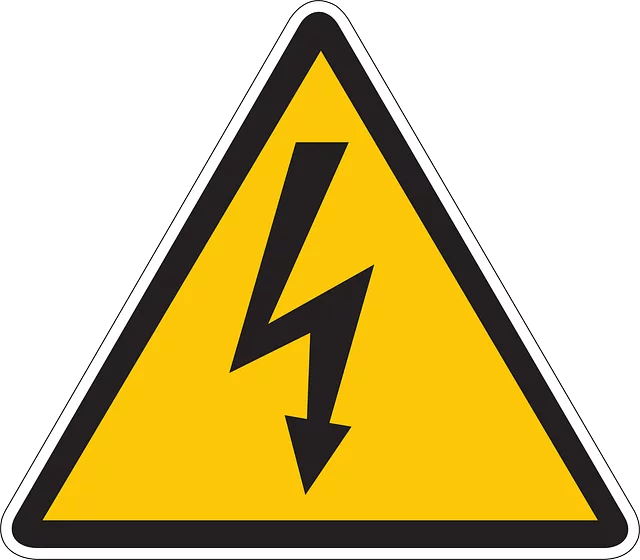OSHA workplace safety inspections are crucial for maintaining health and safety standards in U.S. workplaces. These inspections assess policies, procedures, and physical conditions, focusing on hazard identification, safety data sheet (SDS) compliance, and risk mitigation. Adhering to established hazard assessment protocols and regularly updating SDS documents are essential to prevent fines, legal issues, and reputational damage. Regular OSHA inspections, combined with proactive measures like thorough assessments and employee training, ensure a safer work environment, foster compliance, and protect businesses from severe penalties.
In today’s digital era, understanding the cost of non-compliance is more critical than ever. This comprehensive guide explores OSHA workplace safety inspections, delving into hazard assessment protocols and Safety Data Sheet (SDS) compliance requirements. We examine the financial implications, including hidden costs and legal repercussions, that can plague non-compliant organizations. Furthermore, we provide strategies to prevent non-compliance and foster a safe work environment, emphasizing the importance of adhering to regulatory standards.
- Understanding OSHA Workplace Safety Inspections: A Comprehensive Overview
- The Role of Hazard Assessment Protocols in Compliance
- Demystifying Safety Data Sheet (SDS) Compliance Requirements
- Financial Implications of Non-Compliance: Costs and Consequences
- Legal and Regulatory Ramifications: What Happens During an Inspection?
- Strategies for Preventing Non-Compliance and Ensuring a Safe Work Environment
Understanding OSHA Workplace Safety Inspections: A Comprehensive Overview

OSHA (Occupational Safety and Health Administration) workplace safety inspections are a crucial aspect of ensuring adherence to health and safety standards in the United States. These inspections, conducted by trained OSHA officials, aim to identify potential hazards, assess compliance with safety regulations, and mitigate risks in the workplace. The process involves a thorough review of an organization’s policies, procedures, and physical conditions.
During an inspection, officials will examine various factors, including hazard assessment protocols, safety data sheet (SDS) compliance, personal protective equipment (PPE) availability, training records, and emergency preparedness plans. A key objective is to verify that employers are providing a safe working environment for their employees, as required by federal law. Non-compliance with OSHA standards can result in significant fines, legal repercussions, and damage to an organization’s reputation, highlighting the importance of understanding and adhering to these safety inspection processes.
The Role of Hazard Assessment Protocols in Compliance
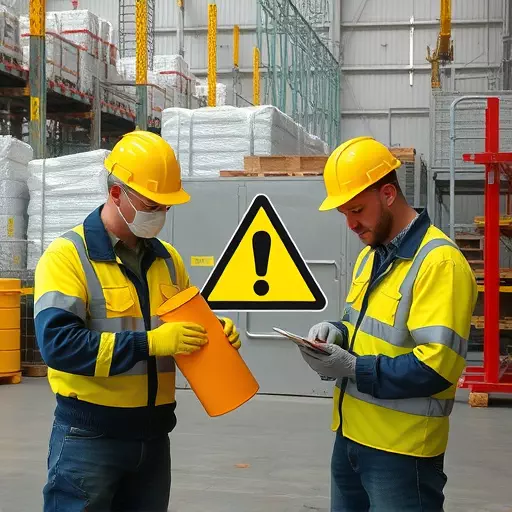
Hazard assessment protocols play a pivotal role in ensuring OSHA workplace safety inspections yield tangible results. These protocols guide inspectors through a systematic evaluation of potential risks within a work environment, enabling them to identify and mitigate hazards effectively. By adhering to established guidelines, organizations can proactively manage safety data sheet (SDS) compliance, thereby reducing the likelihood of costly non-compliance issues.
A robust hazard assessment protocol ensures that every workplace is thoroughly scrutinized for potential dangers. This process involves evaluating chemical exposure, ergonomical factors, and other work-related risks. By prioritizing safety through proactive assessments, businesses can foster a culture of compliance that extends beyond mere adherence to regulations. Ultimately, this approach translates into a safer workspace, minimized liability, and enhanced operational efficiency.
Demystifying Safety Data Sheet (SDS) Compliance Requirements
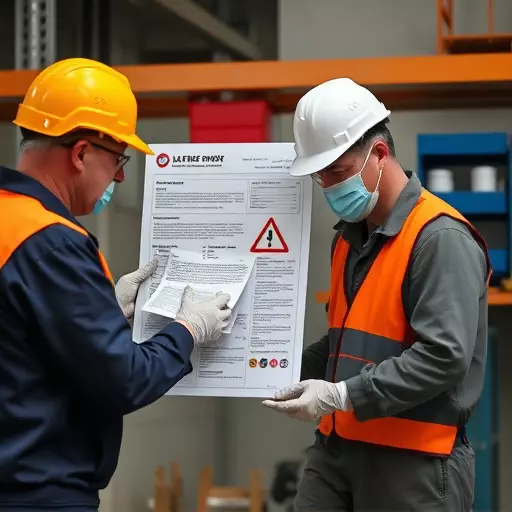
Many businesses often overlook the significance of adhering to Safety Data Sheet (SDS) compliance requirements, especially during OSHA workplace safety inspections. SDS, also known as Material Safety Data Sheets, are crucial documents that provide detailed information about the properties, hazards, and safe handling procedures associated with chemicals and substances used in various industries. Compliance is not just a legal necessity but an essential component of effective workplace safety management.
During inspections, OSHA officials meticulously review these sheets to ensure they contain up-to-date and accurate data on potential risks and the appropriate measures to mitigate them. Non-compliance can lead to severe consequences, including fines, legal repercussions, and most importantly, an unsafe working environment. To meet these requirements, businesses must implement robust hazard assessment protocols, regularly updating their SDS to reflect any changes in chemical compositions or handling procedures. This proactive approach not only facilitates compliance but also empowers employees with knowledge, enabling them to recognize and address potential hazards effectively.
Financial Implications of Non-Compliance: Costs and Consequences
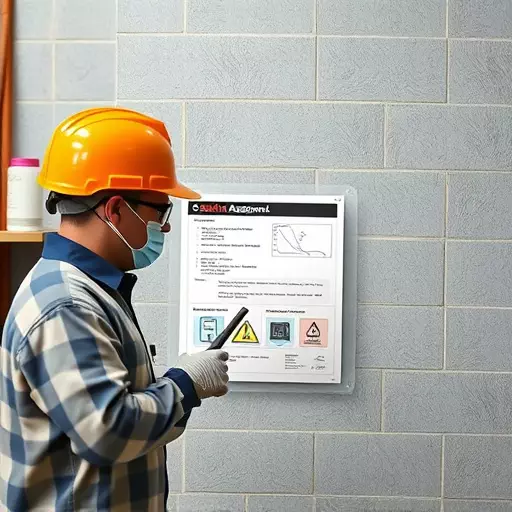
The financial implications of non-compliance with OSHA workplace safety standards can be severe. Companies that fail to adhere to regulations during inspections often face hefty fines, which can range from thousands to tens of thousands of dollars, depending on the severity of the violations. These penalties are designed to serve as a deterrent and ensure businesses prioritize employee safety. Beyond monetary fines, non-compliance can lead to legal liabilities, including compensation for injured workers and potential class-action lawsuits.
Moreover, the cost of non-compliance extends beyond financial losses. It can damage a company’s reputation, erode customer trust, and hinder future growth opportunities. Regular OSHA workplace safety inspections and adherence to hazard assessment protocols are essential steps in mitigating these risks. Ensuring Safety Data Sheet (SDS) compliance further demonstrates a commitment to transparency and worker protection, fostering a safer and more productive work environment.
Legal and Regulatory Ramifications: What Happens During an Inspection?

During OSHA workplace safety inspections, non-compliance with established hazard assessment protocols can lead to significant legal and regulatory ramifications. Inspectors have the authority to issue citations for violations, which may come with substantial fines. These penalties are designed to deter businesses from cutting corners on safety measures and encourage them to uphold compliance with workplace safety standards. Failure to provide a Safety Data Sheet (SDS) during an inspection is a common violation, as it’s crucial for communicating hazardous substances present in the work environment.
The process of an OSHA inspection involves a thorough review of records, observation of working conditions, and interviews with employees. Inspectors look for evidence of hazard assessment procedures, personal protective equipment usage, and proper storage and handling of hazardous materials. Non-compliance can result in immediate shutdowns, especially if the violations pose an imminent danger to workers’ safety and health. Businesses found non-compliant are expected to correct the issues promptly, with ongoing monitoring to ensure sustained compliance moving forward.
Strategies for Preventing Non-Compliance and Ensuring a Safe Work Environment
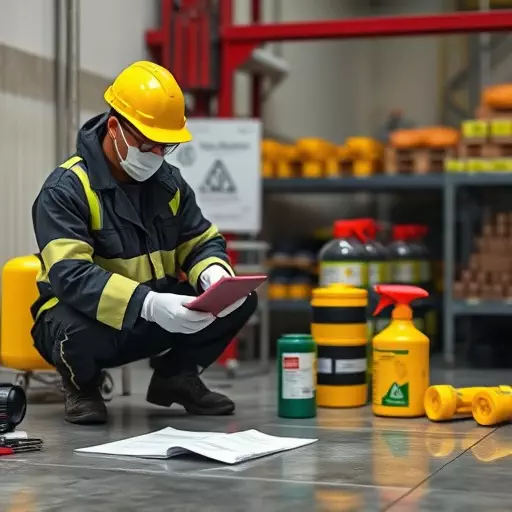
To prevent non-compliance and ensure a safe work environment, organizations should prioritize proactive measures rather than reactive responses. Regular OSHA workplace safety inspections are pivotal in identifying potential hazards and ensuring adherence to regulatory standards. By conducting thorough hazard assessments using established protocols, businesses can proactively pinpoint risks and implement necessary controls. This process involves meticulously evaluating each aspect of the workplace, from equipment operation to chemical storage, to create a comprehensive risk profile.
Additionally, maintaining up-to-date safety data sheets (SDS) for all hazardous materials is indispensable. SDS provide critical information on substance hazards, handling procedures, and emergency responses. Ensuring that employees are trained to access and understand these documents fosters a culture of safety consciousness. Regular updates and distribution of new versions as formulations change guarantee that everyone remains informed about the latest safety guidelines, thereby minimizing the risk of non-compliance during inspections.

